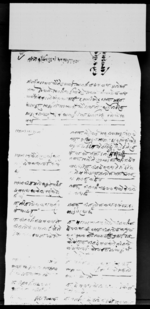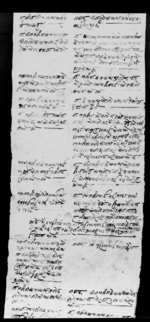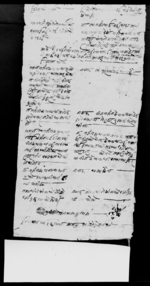A bakapatra supplied by Bhakta Bāhādura Sāhī re Mahanta Chetranātha's abbatial succession in Rānagāũ (VS 1964)
ID: K_0469_0044
Edited and
translated by Christof Zotter
Created: 2018-10-02;
Last modified: 2018-12-07
For the metadata of the document, click here
The accompanying edition, translation/synopsis and/or commentary are available under the terms of the Creative Commons Attribution-ShareAlike 4.0 International License
Abstract
In this statement, made in front of Lieutenant Colonel Vīra Bahādūra Basynāt Kṣetrī of the Salyan district office (gauḍā), Mukhiyā Bhakta Bāhādura Śāhī answers questions regarding the abbotship of Mahanta Chetranātha in Rānagāũ, Salyan.Diplomatic edition
[1r]
1श्रीले•कर्णेलरणवीक्रंवहादुरराणा2\⟪145⟫[seal]1दःलेःकवीरव[...]
2रवस्न्यात्क्ष[...]¯ ¯¯1जील्ल्यैसल्ल्याना•मौजेरानागाऊ•कामहंन्त•छत्रनाथ•प्रलोकभ
2याको•हुनाले•स्वमहंत्याईमामेरो•हकहो•भंन्यालोकनाथ
3का•वींन्तीपत्रमालेषीयाका•साछी•रुहानीकोट्वस्न्या•भक्त•
4वाहादुर•साहीले•सल्ल्यानागौडाका•ले•कर्णैलवीरवा
5हादुरवस्न्यात•छेत्रीकासामुंनेमा•धर्मसम्झीवकेकोवक
6पत्र¯¯ ¯¯¯¯ ¯¯¯¯ ¯¯¯¯
7¯¯¯¯¯¯ ¯¯¯¯ ¯¯¯¯ ¯¯¯¯
[table1]
| 1 | सव़ालमामुली¯¯¯¯¯¯¯ | जवाफमेरोनाऊभक्तवाहादुर•वावुको नाउ•अरीमर्दन•साही•घररुहानीकोट् गाऊमाछऊद्देमषेतीगर्छुमेरोऊमेरव र्ष•५८कोभञा•दर्जामुषीय़ाहुं¯¯¯¯¯¯¯¯¯¯¯¯¯ |
| 2 | सव़ालस्वमौजेरानगाऊकाम हंन्तछेत्रनाथलाई•चीन्छौ की¯¯¯¯¯¯¯¯¯¯ | जवाफ•स्वमौजेरानगाऊका•महंन्तछेत्र नाथथीय़ा•नीजछेत्रनाथ•ये़ही६४सा लजेष्टमैनामा•प्रलोकभय़ादीनवार कासमझ्नाछैन¯¯¯¯¯¯¯¯¯ |
| 3 | सव़ालनीजप्रलोकहुने•महंन्त छत्रनाथकोचेलापनीकोही छंकी¯¯¯¯¯¯¯¯ | जवाफ्नीजमहंन्तछत्रनाथकोचेलालो कनाथछं¯¯¯¯¯¯¯¯¯ |
[1r-part2]
[table1-part2]
| 1 | स•नीजलोकनाथ•कतीव र्षकाछन्¯¯¯¯¯¯¯¯ | जवाफ्नीज•लोकनाथ•वर्ष१२।१३ काउमेरकाछं¯¯¯¯¯¯¯¯¯ |
| 2 | स•नीजमहंन्तछत्रनाथले नीजलोकनाथलाईकैले देषीचेलावनाय़ाकोहो• | ज•५८।५९सालमाकेहो•नीजमहंन्त• छेत्रनाथ•पीरवस्ता•नीजलोकनाथका वावु•आमावाटत्यागगरी•चुकाई•दाङ् चौघेरामा•नीजछेत्रनाथलेनीजलो कनाथलाई चेलावनाय़ाकाहुंभं दासुनेकोहुं•¯¯¯ ¯¯¯ ¯¯¯ |
| 3 | सव़ाल•महंन्तछत्रनाथप्रलो कभय़ाकोहुनाले•स्वमहंत्या ईकोहककस्कोहो¯¯ | जमहंन्त•छत्रनाथ•प्रलोकभय़ा कोहुनाले•स्वमहंत्याई•कोहकलो कनाथकोहो¯¯¯ ¯¯¯¯¯¯¯¯¯ |
| 4 | स•नीजमहंन्तछत्रनाथका अरुचेलापनीछंकी¯¯¯ | ज•छेत्रनाथकोलोकनाथदेषीअ रुचेला•छैनं• ¯¯¯¯¯¯¯¯¯ |
| 5 | स•महंत्याईहुंदा•सावीक• दरसावीकमा•केकेगरीआ य़ाको•हो• ¯¯¯¯¯¯¯¯¯ | ज•महहंन्तकोप्रलोकहुने•अवस्ताभ य़ापछीचेलालेगरुमैलेकेगरनेहोभनी स्व्द्धा•निजछेत्रनाथलेपाषुरासमाई•चेलाकोपीठ्मा धापमारीदी•महंत्याईभैवस्नु•भनीभनेपछी स्वमहंन्तप्रलोकभय़ापछीगरीआय़ाव मोजीमकाजकृय़ा•गरी•चेलालेमहं तभैगद्दीमा•वस्नागरीआ याकोछ•¯¯ |
| 6 | सव़ालमहंन्तछेत्रनाथ•लाई• कस्ले•चेलावनाई•महंत्या ईदीय़ाको•हो¯¯¯¯¯¯ | ज•नीजमहंन्त•छेत्रनाथकोगुरुम हंत•हीरानाथलेनीजछेत्रनाथला ई•चेलावनाई•महंत्याईपाऊनेगरीरा षेकाहुं•¯¯¯¯ ¯¯¯¯ ¯¯¯¯ |
| 7 | सव़ालमहंतहुनेलेसकार•मा• वक्साई•गद्दीवस्छंकीआफै वस्दछं¯¯¯¯¯¯ | स•स्वमहंत्याई•गद्दीवस्दा•सावी कदरसावीकदेषी•महंन्तपर्लोकभ य़ापछी•चेलालेय़सगौडाकाभारादा रसंगजाहेर•गरीय़सगौडाकाभारादार आफै•गै१पट्टीसीपाहीलीगद्दीमावसाईसर्कारमाजाहेरगर्ने गरेकाछंगद्दीभय़ापछीमहंतलेआफ्नानाऊमासनदपुर्जी⟪[seal of Bhaktabāhādura]⟫⟪लालमोहर⟫⟪[seal of Bhaktabāhādura]⟫गरा ई•आय़ाकाछं¯¯ ¯¯¯¯¯¯ ¯¯¯¯¯¯¯¯ |
| 8 | सव़ाल•महंन्तछत्रनाथ•प्रलो कहुनेवषत्•मास्वमठ्कोका म•तीमीलेगर्नु•भनी•नीजछ त्रनाथले•मलाई•अषतीय़ा रीदी•य़ाकोछभनी•देवीना थजीले•ऊजुरगरेकोछस्व कुराहोकी ¯¯¯¯¯¯¯¯ | जवाफ्स्वकुरामलाईथाहाछैन¯¯ |
| 9 | समहंन्तछत्रनाथ•प्रलोक हुनेवषत्तीमीकाहाथी य़ौ¯¯¯¯¯¯¯¯¯¯¯¯ | जवाफ्नीजमहंतछेत्रनाथप्रलोक हुनेवषत्ममेराघररुहानीकोट्मा थीञा¯¯¯¯¯¯¯¯¯¯¯¯ |
[1r-part3]
[table1-part3]
| 1 | सव़ाल•स्वमहंतछत्रनाथ लाई•महंत्याईदीय़ापछी नीजछत्रनाथगद्दीमावस्ना लाई•सल्ल्यांगौडाकाभा रादारसंगवक्साय़ाकोथी य़ोथीय़न¯¯¯¯¯¯ | ज•महंतछत्रनाथप्रलोकभय़ाप छी•नीजकोचेला•छत्रनाथ•गद्दीवस्ना लाईऊसवषतका•सल्ल्यांगौडाका भारादार•¯ ¯ ¯कोपनीसव़ारीभैगद्दी मानीजछेत्रनाथ•वस्याकाहुं¯¯ |
| 2 | स•महंतछत्रनाथकाम ठ्कोआम्दानीकतील गतकतीछ¯¯¯¯¯¯¯¯ | जवाफ्थाहाछैन |
| 3 | समाथीलेषीय़ाकोतीम्रो वय़ांदुरुस्तसाचोहोकी¯¯ | जवाफ्य़ोमाथीलेषीय़ाकोवयांदुरुस्तसाचोहो¯¯¯¯¯¯¯¯ |
8मुषीय़ाभकतवाहादुरसाही¯¯¯¯¯ \
9ईतीसम्वत१९६४साल•श्रावण१०गतेरोज५शुभं¯¯ ¯¯1 [seal of Bhakta Bāhādura] 1दःले•कः
2सहि
Translation
[1r-part1]
Venerable L[ieutenant] Colonel Raṇavīkraṃ Bahādura Rāṇā
451
[seal]
[signature of] Da.2 L[ieutenant] C[olonel] Vīra Bahādūra Basynāt Kṣatrī - - -
Testimony (bakapatra) given, keeping the dharma in mind, in front of L[ieutenant] Colonel Vīra Bahādura Basynāta Chetrī of the Salyan district office (gauḍā) by Bhakta Bāhādura Sāhī, a resident of Ruhānīkoṭ3 [and] witness mentioned (lekhīyāko) in the petition (bintīpatra) from Lokanātha which states "inasmuch as Chetranātha,4 the abbot (mahanta) of Rānāgāũmaujā, Salyan district (jillā) , has passed away, the right to the abbotship is [now] mine."5
[table]
| Question: general [introduction] | Answer: My name [is] Bhakta Bāhādura ; [my] father's name [is] Arīmardana Sāhī. [My] home is in Ruhānīkoṭ village. Profession:6 I do fieldwork. My age is 58 years. Rank: I am the mukhiyā. | |
| Question: You knew Mahanta Chetranātha of the that7 maujā, Rānāgāũ, or not? | Answer: The mahanta of that maujā, Rānāgāũ, was Chetranātha. The said Chetranātha passed away in the month of Jyeṣṭha of this year, [VS 19]64. The day [and] weekday I do not remember.8 | |
| Question: Was there also some disciple of the said late Mahanta Chetranātha, or not? | Answer: There was a disciple of the said Mahanta Chetranātha: Lokanātha. |
[1r-part2]
[table]
| Question: How old is the said Lokanātha? | Answer: The said Lokanātha is 12 or 13 years old. | |
| Question: When did the said Mahanta Chetranātha make the said Lokanātha [his] disciple? | Answer: Was it in the year [VS 19]58 or [19]59?9 I have heard [the people] saying that when the said Mahanta Chetranātha was residing as head of the monastery (pīra) in DangCaugherā10 [and] the said Lokanātha had already left [his] father [and] mother, the said Chetranātha made the said Lokanātha [his] disciple. | |
| Question: Now that Mahanta Chetranātha has passed away, who has the right to the abbotship? | Answer: Now that Mahanta Chetranātha has passed away, the right to the abbotship is Lokanātha's. | |
| Question: There are other disciples of the said Mahanta Chetranātha, or not? | Answer: There are no other disciples of Chetranātha than Lokanātha. | |
| Question: What all is traditionally done in the customary practice when one accedes to the abbotship ( mahantyāñī hundā)? | Answer: When the mahanta was about to die, the disciple asked, "Guru, what shall I do?" The said Chetranātha seized the [disciple's] upper arm, slapped the disciple's back, [and] said: "Accede to the abbotship [and] occupy [the throne]." After the mahanta passed away, the disciple performed the kājakṛyā11 according to what is traditionally practised, became mahanta [and now] occupies the throne. [This is what] is traditionally done. | |
| Question: Who made Mahanta Chetranātha [his] disciple [and] gave [him] the abbotship? | Answer: The guru of the said Mahanta Chetranātha, Mahanta Hīrānātha, made the said Mahanta Chetranātha [his] disciple and appointed him [his successor] so that he would receive the abbotship. | |
| Question: Is it the tradition that a mahanta-to-be occupies the throne after being authorized by the government, or is it rather the tradition that he occupies [it] on his own? | Answer: Once the [one who is selected for] the abbotship [is set to] occupy the throne, it is the tradition that, after the mahanta has passed away, the disciple informs the bhārādāra of this district office (gauḍā), the bhārādāra of the gaudā himself goes [to Rānāgāũ] with a squad (paṭṭī) of soldiers, authorizes [the disciple] to occupy the throne [and] informs the government. It is the tradition that, once the gaddī is [occupied], the mahanta has a sanada [and] a lālamohara12 issued in his name. | |
| Question: Devīnāthajī has submitted a complaint, saying: "When Mahanta Chetranātha was passing away, the said Chetranātha gave me the authority, saying 'You do the work of [overseeing] the maṭha'."13 It is so, or not? | Answer: I do not know about that. | |
| Question: Where were you when Mahanta Chetranātha passed away? | When the said Mahanta Chetranātha passed away I was at home in Ruhānīkoṭ. |
[1r-part3]
[table]
| Question: After the said Chetranātha was given the abbotship (by his guru), was the said Chetranātha authorized to occupy the throne by the bhārādāra of the Salyan district office, or not? | Answer: After Mahanta Hīrānātha14 passed away, in order for his (nījako) disciple Chetranātha to [be able to] occupy the throne, the then bhārādāra of the Salyan district office, [venerable L[ieutenant] Colonel Raṇavīkraṃ Bahādūra Rāṇā], 15 came (savārī bhai) and the said Chetranātha occupied the throne. | |
| Question: How much was Mahanta Chetranātha’s assessment of the maṭha revenue? | Answer: I do not know. | |
| Question: Is the declaration of yours written above the exact truth, or not? | Answer: The declaration of mine written above is the exact truth. |
Mukhiyā Bhakta Bāhādura Sāhī
16 - - -
[seal of Bhakta Bāhādura Sāhī]17
signature Da.18 L[ieutenant] C[olonel]
Thursday, the 10th solar day (gate) of Śrāvaṇa in the [Vikrama] era year 1964 (1907 CE). Auspiciousness.
Commentary
The document is one of the witness statements19 that were sent from Salyan to Kathmandu in support of a petition from Lokanātha to be recognized as successor to the abbatial throne (see K_0469_0033).



